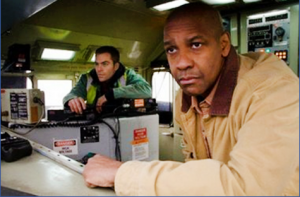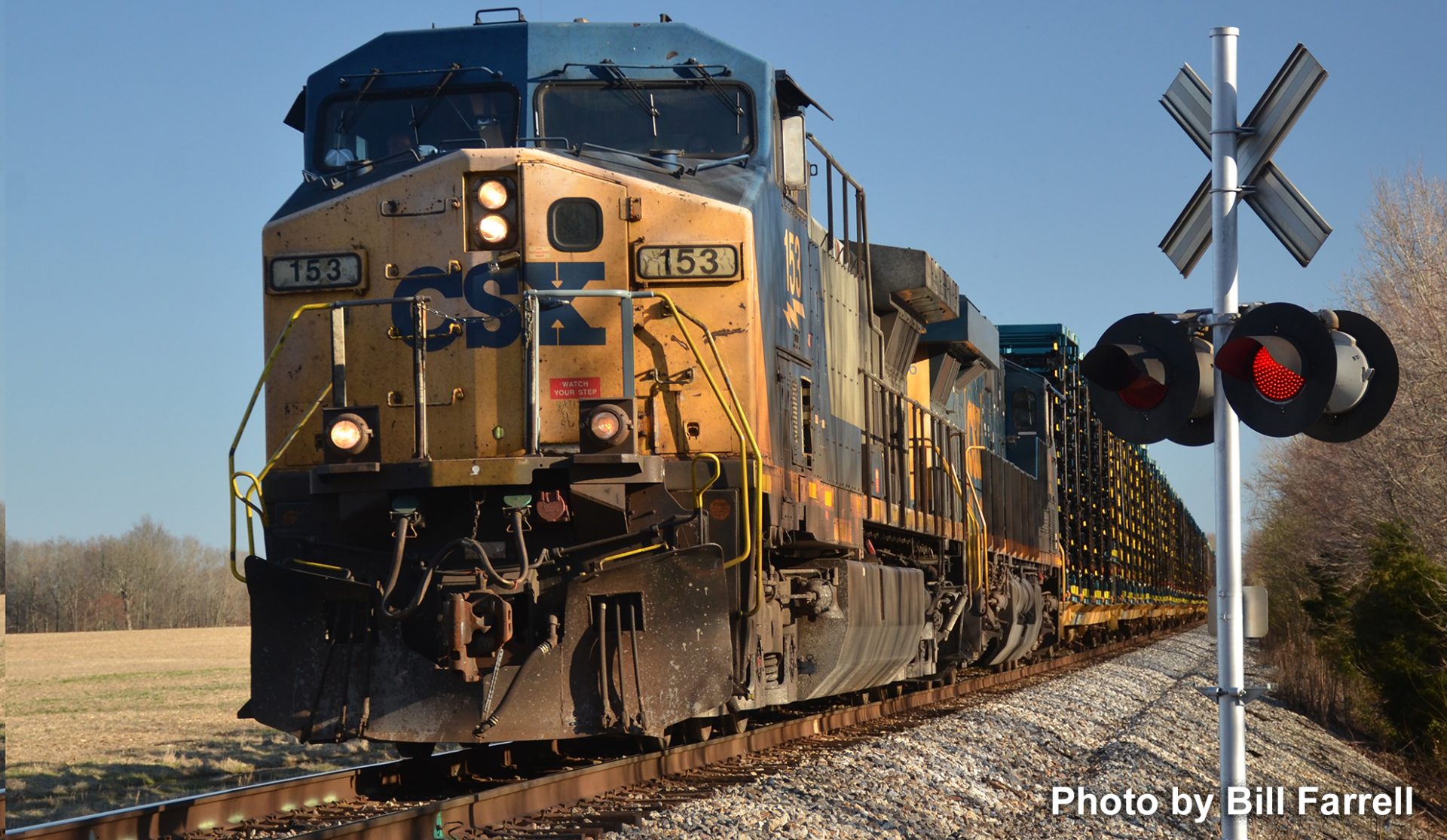Part 1 (Part 2 to follow in January edition)
Submitted by Chris Dees
 With the movie “Unstoppable” being released in theaters this Friday, I thought I’d share the official investigation by CSX Transportation regarding the actual incident that the movie is based on.
With the movie “Unstoppable” being released in theaters this Friday, I thought I’d share the official investigation by CSX Transportation regarding the actual incident that the movie is based on.
Synopsis
On May 15, 2001, at approximately 12:35 p.m., DST, an unmanned CSX yard train consisting of one model SD-40-2 locomotive, 22 loaded, and 25 empty cars, 2898 gross trailing tons, departed Stanley Yard, which is located in Walbridge, Ohio. The uncontrolled movement proceeded south for a distance of 66 miles before CSX personnel were able to bring the movement under control. At the time of the incident, the weather was cloudy with light rain. The ambient temperature was 55 degrees Fahrenheit. There was no derailment of equipment or collision. There were no reportable injuries as a result of the incident.
Circumstances Prior to Incident
Yard crew Y11615, consisting of one engineer, one conductor and one brakeman, reported for duty at Stanley Yard, Walbridge, Ohio, at 6:30 am, DST, May 15, 2001. After the normal job briefing with the trainmaster, crew Y11615 performed routine switching assignments until approximately 11:30 am, at which time the crew received new instructions and a second job briefing. A few minutes before 12:30 p.m., the crew entered the north end of track K12, located in the classification yard, with the intent to pull 47 cars out of K12 and then place these cars on departure track D10. Locomotive CSX 8888 was positioned with the short hood headed north. The engineer was seated at the controls on the east side of the locomotive.
The locomotive coupled to the 47 cars on track K12, as instructed and planned. The air hoses between the locomotive and the cars were not connected, as is normal during this kind of switching operation. The air brakes on the cars were therefore inoperative. The brakeman notified the engineer by radio to pull north from K12. After the rear or 47th car passed the brakeman’s location, he walked west to position the switch for the reverse movement to proceed into the assigned track D10.
The movement continued north out of K12 passing the conductor, who was positioned on the ground at the “Camera” switch. The conductor advised the engineer by radio of the number of cars that had passed him and received an acknowledgement from the engineer by radio.
The Incident
With eight cars remaining to pass over the “Camera” switch, the conductor notified the engineer by radio to prepare to stop. The engineer did not respond to his communication. The conductor again notified the engineer when four cars remained to clear the switch, but again there was no response from the engineer. The conductor then ordered the engineer to stop movement, but again there was no response from the engineer and the movement continued.
In his interview, the engineer stated that as he pulled north out of K12, he was notified by radio by the conductor that the trailing point switch for track PB9 off the lead was reversed. The engineer understood that it would be necessary for the movement to be stopped short of the PB9 switch in order to line the switch for movement further along the lead. Neither the conductor nor the brakeman were near the PB9 switch, and the engineer intended to stop his train, dismount from the locomotive, and align the switch to its normal position, if necessary. The speed of the movement up the lead had now reached 11 mph. The engineer observed the reversed switch, but due to the wet rail conditions and the number of cars coupled to his locomotive, he foresaw that he could not bring the equipment to a stop prior to passing through the misaligned switch.
The engineer responded by applying the locomotive’s independent brake to full application. The independent brake applies the brakes on the locomotive but does not apply the brakes on the individual freight cars. In addition, he reduced brake pipe pressure with a 20 psi service application of the automatic brake valve. The automatic brake is pneumatic braking system designed to control the brakes on the entire train. Still certain he would not stop short of the switch the engineer attempted to place the locomotive in dynamic brake mode. The dynamic brake utilizes the locomotive propulsion system to brake the train. Dynamic braking is analogous to down shifting a truck or automobile. Unfortunately, the engineer inadvertently failed to complete the selection process to set up the dynamic brake. Under the mistaken belief that he had properly selected dynamic brake, the engineer moved the throttle into the number 8 position for maximum dynamic braking. The engineer believed that the dynamic brake had been selected and that additional braking would occur. However, since dynamic brake set up had not been established, the placing of the throttle into the number 8 position restored full locomotive power, instead of retarding forward movement of the train.
While the train was still moving at a speed of approximately 8 mph, the engineer dismounted the locomotive and ran ahead to reposition the switch before the train could run through and cause damage to the switch. The engineer was successful in operating the switch just seconds before the train reached it. The engineer than ran along side the locomotive and attempted to reboard. However, the speed of the train had not decreased as the engineer had expected but had increased to approximately 12 mph. Due to poor footing and wet grab handles on the locomotive, the engineer was unable to pull himself up on the locomotives ladder. He dragged along for approximately 80 feet until he released his grip on the hand rails and fell to the ground.
Unable to reboard and stop the movement of his train, the engineer ran to contact a railroad employee, not a member of his crew but in possession of a radio, located at the north end of the yard. This employee immediately notified the yardmaster of the runaway train. The yardmaster promptly notified the Stanley tower block operator and the trainmaster. The Toledo Branch train dispatcher located in Indianapolis was also notified. The movement was now proceeding southward on the Toledo Branch (Great Lakes Division) governed by Traffic Control System (TCS) Rules. The time was approximately 12:35 p.m.
The brakeman observed the train depart the yard but did not initially see the engineer on the ground. The brakeman and another employee used a personal vehicle to pursue the train to the next grade crossing to attempt to board the train. Their immediate concern was for the safety of the engineer, who they feared may have suffered a heart attack while at the controls of the locomotive. At the grade crossing, the two employees were unable to board the train as the speed had increased to approximately 18 mph as it passed the mile post 4. Local authorities and the Ohio State Police were notified of the runaway train at approximately 12:38 p.m.
Attempts to Stop the Runaway
At a siding called Galatea, near mile post 34, at approximately 1:35 p.m., the train dispatcher remotely operated the switch for the train to enter the siding. Previously a portable derail had been placed on the track in an attempt to derail the locomotive and thereby stop the movement. The portable derail was, however, dislodged and thrown from the track by the force of the train passing over it, and the movement of the train was not impeded.
Northbound train Q63615 was directed by the dispatcher into the siding at Dunkirk, Ohio. The crew was instructed to uncouple their single locomotive unit from their train and wait until the runaway passed their location. at approximately 2:05 p.m., the runaway train passed Dunkirk, and the siding was lined for the crew of Q63615 to enter the main track and to pursue the runaway train.
At Kenton, Ohio, near mile post 67, the crew of Q63615 successfully caught the runaway equipment and succeeded in coupling to the rear car, at a speed of 51 mph. The engineer gradually applied the dynamic brake of his locomotive, taking care not to break the train apart. By the time the train passed over Route 31 south of Kenton, the engineer had slowed the speed of the train to approximately 11 mph. Positioned at the crossing was CSX Trainmaster Jon Hosfeld, who was able to run along side the unmanned locomotive and climb aboard. The trainmaster immediately shut down the throttle, and the train quickly came to a stop. The time was 2:30 p.m. and the runaway train had covered 66 miles in just under 2 hours.
An examination of the controls confirmed that the locomotive independent brake had been fully applied, automatic brake valve was in the service zone, and the dynamic brake selector switch was not in the braking mode. All brake shoes had been completely worn to the brake beams. The railroad was prepared to place an additional fully manned locomotive ahead of the runaway south of Kenton, if necessary, to further slow the train. This rather hazardous option was fortunately not required.
(To be continued in January 2011)
